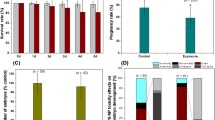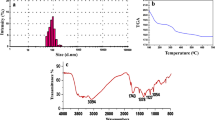Abstract
Exposing living organisms to nanoparticulates is potentially hazardous, in particular when it takes place during embryogenesis. In this investigation, we have studied the effects of 50-nm-uncoated polystyrene nanoparticles (PSNPs) as a model to investigate the suitability of their possible future employments. We have used the standardized Frog Embryo Teratogenesis Assay-Xenopus test during the early stages of larval development of Xenopus laevis, and we have employed either contact exposure or microinjections. We found that the embryos mortality rate is dose dependent and that the survived embryos showed high percentage of malformations. They display disorders in pigmentation distribution, malformations of the head, gut and tail, edema in the anterior ventral region, and a shorter body length compared with sibling untreated embryos. Moreover, these embryos grow more slowly than the untreated embryos. Expressions of the mesoderm markers, bra (T-box Brachyury gene), myod1 (myogenic differentiation1), and of neural crest marker sox9 (sex SRY (determining region Y-box 9) transcription factor sox9), are modified. Confocal microscopy showed that the nanoparticles are localized in the cytoplasm, in the nucleus, and in the periphery of the digestive gut cells. Our data suggest that PSNPs are toxic and show a potential teratogenic effect for Xenopus larvae. We hypothesize that these effects may be due either to the amount of NPs that penetrate into the cells and/or to the “corona” effect caused by the interaction of PSNPs with cytoplasm components. The three endpoints of our study, i.e., mortality, malformations, and growth inhibition, suggest that the tests we used may be a powerful and flexible bioassay in evaluating pollutants in aquatic embryos.








Similar content being viewed by others
References
Bacchetta R, Santo N, Fascio U, Moschini E, Freddi S, Chirico G, Camatini M, Mantecca P (2012) Nano-sized CuO, TiO2 and ZnO affect Xenopus laevis development. Nanotoxicology 6(4):381–398
Bantle JA, Dawson DA (1988) Uninduced rat liver microsomes as a metabolic activation system for the frog embryo. In: Adams WJ, Chapman GA, Landis WF (eds) Aquatic toxicology and hazard assessment, ASTM STP 971. ASTM, Philadelphia, p 316
Bosman SJ, Nieto SP, Patton WC, Jacobson JD, Corselli JU, Chan PJ (2005) Development of mammalian embryos exposed to mixed-size nanoparticles. Clin Exp Obstet Gynecol 32(4):222–224
Browning LM, Lee KJ, Huang T, Nallathamby PD, Lowman JE, Xu XN (2009) Random walk of single gold nanoparticles in zebrafish embryos leading to stochastic toxic effects on embryonic developments. Nanoscale 1:138–152
Cabaleiro-Lago C, Lynch I, Dawson KA, Linse S (2010) Inhibition of IAPP and IAPP(20–29) fibrillation by polymeric nanoparticles. Langmuir 26:3453–3461
Casado MP, Macken A, Byrne HJ (2013) Ecotoxicological assessment of silica and polystyrene nanoparticles assessed by a multitrophic test battery. Environ Int 51(2013):97–105
Cedervall T, Lynch I, Foy M, Berggård T, James P et al (2007) Detailed identification of plasma proteins absorbed to copolymer nanoparticles. Angew Chem Int Ed 46:5754–5756
Cedervall T, Hansson L-A, Lard M, Frohm B, Linse S (2012) Food chain transport of nanoparticles affects behaviour and fat metabolism in fish. PLoS One 7(2):e32254. doi:10.1371/journal.pone.0032254
Chalmers AD, Slack JMW (1998) Development of the gut in Xenopus laevis. Dev Dynam 212:509–521
Chang C (2010) The immune effects of naturally occurring and synthetic nanoparticles. J Autoimmun 34:234–246
Dell’Orco D, Lundqvist M, Oslakovic C, Cedervall T, Linse S (2010) Modelling the time evolution of the nanoparticle-protein corona in a body fluid. PLoS One 5:e10949
Dumont JN, Schultz TW, Buchanan M, Kao G (1983) Frog embryo teratogenesis assay-Xenopus (FETAX)–a short– term assay applicable to complex environmental mixtures. In: Waters MD, Sandhu SS, Lewtas J, Claxton L, Chernoff N, Nesnow S (eds) Short-term bioassays in the analysis of complex environmental mixtures. Plenum Press, New York, pp 393–405
El Jamil A, Kanhoush R, Magre S, Boizet-Bonhoure B, Penrad-Mobayed M (2008) Sex-specific expression of sox9 during gonadogenesis in the amphibian Xenopus tropicalis. Dev Dyn 237(10):2996–3005
Enright HA, Bratt JM, Bluhm AP, Kenyon NJ, Louie AY (2013) Tracking retention and transport of ultrafine polystyrene in an asthmatic mouse model using positron emission tomography. Exp Lung Res 39(7):304–313
Fan Z, Yang X, Li Y, Li S, Niu S, Wu X, Wei J, Nie G (2012) Deciphering an underlying mechanism of differential cellular effects of nanoparticles: an example of Bach-1 dependent induction of HO-1 expression by gold nanorod. Biointerphases 7(1–4):10. doi:10.1007/s13758-011-0010-x
Fent K, Weisbrod CJ, Wirth-Heller A, Pieles U (2010) Assessment of uptake and toxicity of fluorescent silica nanoparticles in zebrafish (Danio rerio) early life stages. Aquat Toxicol 100:218–228
Fleischer CC, Payne CK (2014) Secondary structure of corona proteins determines the cell surface receptors used by nanoparticles. J Phys Chem B 118(49):14017–14026
Gont LK, Steinbeisser H, Blumberg B, De Robertis EM (1993) Tail formation as a continuation of gastrulation: the multiple cell populations of the Xenopus tailbud derive from the late blastopore lip. Development 119(4):991–1004
Guarnieri D, Guaccio A, Fusco S, Netti PA (2011) Effect of serum proteins on polystyrene nanoparticle uptake and intracellular trafficking in endothelial cells. J Nanopart Res 13:4295–4309. doi:10.1007/s11051-011-0375-2
Guarnieri D, Falanga A, Muscetti O, Tarallo R, Fusco S, Galdiero M, Galdiero S, Netti PA (2013) Shuttle-mediated nanoparticle delivery to the blood-brain barrier. Small 9(6):853–862
Hardy CL, Lemasurier JS, Mohamud R, Yao J, Xiang SD, Rolland JM, O’Hehir RE, Plebanski M (2013) Differential uptake of nanoparticles and microparticles by pulmonary APC subsets induces discrete immunological imprints. J Immunol 91(10):5278–5290
Hopwood ND, Pluck A, Gurdon JB (1989) MyoD expression in the forming somites is an early response to mesoderm induction in Xenopus embryos. EMBO J 8(11):3409–3417
Hopwood ND, Pluck A, Gurdon JB, Dilworth SM (1992) Expression of XMyoD protein in early Xenopus laevis embryos. Development 114(1):31–38
Jani P, Halbert G, Langridge J, Florence A (1990) Nanoparticle uptake by the rat gastrointestinal mucosa: quantization and particle size dependency. J Pharm Pharmacol 42:821–826
Kahru A, Dubourguier H-C (2010) From ecotoxicology to nanoecotoxicology. Toxicology 269:105–119
Krysanov EYu, Pavlov DS, Demidova TB, Dgebuadze YuYu (2010) Effect of nanoparticles on aquatic organisms. Biol Bull 37:406–412
Kumar C (2006) Nanomaterials: toxicity, health, and environmental issues. In: Kumar C (ed) Nanotechnologies for the Life Sciences Vol 5, 1st edn. Weinheim, Wiley-VCH, pp 393–405
Kumar V, Kumari A, Guleria P, Yadav SK (2012) Evaluating the toxicity of selected types of nanochemicals. Rev Environ Contam Toxicol 215:39–121. doi:10.1007/978-1-4614-1463-6_2
Kwan KM, Kirschner MW (2003) Xbra functions as a switch between cell migration and convergent extension in the Xenopus gastrula. Development 130:1961–1972
Lai SK, Hida K, Man ST, Chen C, Machamer C, Schroer TA, Hanes J (2007) Privileged delivery of polymer nanoparticles to the perinuclear region of live cells via a non-clathrin, non-degradative pathway. Biomaterials 28(18):2876–2884
Le Douarin NM, Creuzet S (2011) Neural crest and vertebrate evolution. Biol Aujourdhui 205(2):87–94
Lee KJ, Nallathamby PD, Browning LM, Osgood CJ, Xu XN (2007) In vivo imaging of transport and biocompatibility of single silver nanoparticles in early development of zebrafish embryos. ACS Nano 1:133–143
Liu YX, Li W, Lao F, Liu Y, Wang LM, Bai R (2011) Intracellular dynamics of cationic and anionic polystyrene nanoparticles without direct interaction with mitotic spindle and chromosomes. Biomaterials 32:8291–8303
Lundqvist M, Stigler J, Elia G, Lynch I, Cedervall T et al (2008) Nanoparticle size and surface properties determine the protein corona with possible implications for biological impacts. Proc Natl Acad Sci USA 105:14265–14270
Lundqvist M, Stigler J, Cedervall T, Bergga T, Flanagan MB, Lynch I, Elia G, Dawson K (2011) The Evolution of the protein corona around nanoparticles: a test study. ACS Nano 5(9):7503–7509
Mahler GJ, Esch MB, Tako E, Southard TL, Archer SD, Glahn RP, Shuler ML (2012) Oral exposure to polystyrene nanoparticles affects iron absorption. Nat Nanotechnol 7:264–271. doi:10.1038/nnano
McCarthy J, Gong X, Nahirney D, Duszyk M, Radomski M (2011) Polystyrene nanoparticles activate ion transport in human airway epithelial cells. Int J Nanomed 6:1343–1356. doi:10.2147/IJN.S21145
Nam J, Won N, Bang J, Jin H, Park J, Jung S, Jung S, Park Y, Kim S (2013) Surface engineering of inorganic nanoparticles for imaging and therapy. Adv Drug Deliv Rev 65(5):622–648
Nieuwkoop PD, Faber J (1956) Normal table of Xenopus laevis (Daudin). North Holland Publishing Co, Amsterdam
Oslakovic C, Cedervall T, Linse S, Dahlbäck B (2012) Polystyrene nanoparticles affecting blood coagulation. Nanomedicine 8(6):981–986. doi:10.1016/j.nano.2011.12.001
Pompa PP, Vecchio G, Galeone A, Brunetti V, Sabella S, Maiorano G, Falqui A, Bertoni G, Cingolani R (2010) In vivo toxicity assessment of gold nanoparticles in Drosophila melanogaster. Nano Res 4(4):405–413
Sanfins E, Augustsson C, Dahlbäck B, Linse S, Cedervall T (2014) Size-dependent effects of nanoparticles on enzymes in the blood coagulation cascade. Nano Lett 14:4736–4744. doi:10.1021/nl501863u
Scales JB, Olson EN, Perry M (1990) Two distinct Xenopus genes with homology to MyoD1 are expressed before somite formation in early embryogenesis. Mol Cell Biol 10(4):1516–1524
Scown TM, van Aerle R, Tyler CR (2010) Do engineered nanoparticles pose a significant threat to the aquatic environment? Crit Rev Toxicol 40:653–670
Smith JC, Price BM, Green JB, Weigel D, Herrmann BG (1991) Expression of a Xenopus homolog of Brachyury (T) is an immediate-early response to mesoderm induction. Cell 67(1):79–87
Spokony RF, Aoki Y, Saint-Germain N, Magner-Fink E, Saint-Jeannet J-P (2002) The transcription factor Sox9 is required for cranial neural crest development in Xenopus. Development 129:421–432
Symens N, Walczak R, Demeester J, Mattaj I, De Smedt SC, Remaut K (2011) Nuclear inclusion of nontargeted and chromatin-targeted polystyrene beads and plasmid DNA containing nanoparticles. Mol Pharm 8(5):1757–1766. doi:10.1021/mp200120v
Takagi C, Sakamaki K, Morita H, Hara Y, Suzuki M, Kinoshita N, Ueno N (2013) Transgenic Xenopus laevis for live imaging in cell and developmental biology. Develop Growth Differ 55(4):422–433
Taylor MV, Gurdon JB, Hopwood ND, Towers N, Mohun TJ (1991) Xenopus embryos contain a somite-specific, MyoD-like protein that binds to a promoter site required for muscle actin expression. Genes Dev 5(7):1149–1160
Tian F, Razansky D, Estrada GG, Semmler-Behnke M, Beyerle A, Kreyling W, Ntziachristos V, Stoeger T (2009) Surface modification and size dependence in particle translocation during early embryonic development. Inhal Toxicol Suppl 1:92–96. doi:10.1080/08958370902942624
Tomlinson ML, Field RA, Wheeler GN (2005) Xenopus as a model organism in developmental chemical genetic screens. Mol BioSyst 1:223–228
Vaccaro MC, Cuccaro M, De Marco N, Campanella C (2006) Expression of p27BBP/eIF6 is highly modulated during Xenopus laevis embryogenesis. Mol Reprod Dev 73(4):482–490
Wick P, Malek A, Manser P, Meili D, Maeder-Althaus D, Diener L, Diener P-A, Zisch A, Krug HF, von Mandach U (2010) Barrier capacity of human placenta for nanosized materials. Environ Health Perspect 118:432–436
Xu R, Xiong B, Zhou R, Shen H, Yeung ES, He Y (2014) Pericellular matrix plays an active role in retention and cellular uptake of large-sized nanoparticles. Anal Bioanal Chem 406(20):5031–5037. doi:10.1007/s00216-014-7877-6
Yamamoto A, Honma R, Sumita M, Hanawa T (2004) Cytotoxicity evaluation of ceramic particles of different sizes and shapes. J Biomed Mat Res 68A:244–256
Yanagisawa KO, Fujimoto H, Urushihara H (1981) Effects of the brachyury (T) mutation on morphogenetic movement in the mouse embryo. Dev Biol 87(2):242–248
Acknowledgments
The authors wish to thank C. Campanella for her suggestions, and A. Fazzolini for laboratory assistance. This work was supported by the Grant FARO (Finanziamento per l’Avvio di pROgetti Speciali) and by the departmental research funding (Project: A10113.CRRDI; F.S.2.18.03).
Author information
Authors and Affiliations
Corresponding author
Electronic supplementary material
Below is the link to the electronic supplementary material.
Rights and permissions
About this article
Cite this article
Tussellino, M., Ronca, R., Formiggini, F. et al. Polystyrene nanoparticles affect Xenopus laevis development. J Nanopart Res 17, 70 (2015). https://doi.org/10.1007/s11051-015-2876-x
Received:
Accepted:
Published:
DOI: https://doi.org/10.1007/s11051-015-2876-x




